Tips on using a DeWalt Router
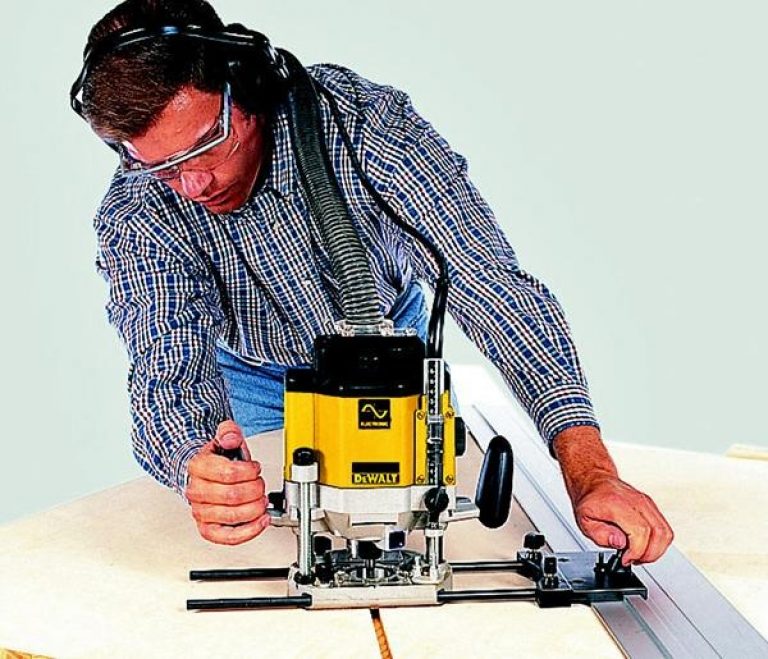
Getting Started
Choose the correct cutter for the task. Using the right router bit will not only produce better results but will keep the cutter sharp for longer.
For instance, a high-speed steel bit is best suited to non-abrasive materials, so using it on a thick plywood board will soon make it go blunt. Always ensure you turn off and unplug your router before inserting or changing bits.
Make sure the bit is fully secured in the collet, and if it’s a variable speed router check that it’s set to the correct speed before switching on.
Connect up a dust extraction system if you have one, to avoid breathing in harmful particles.
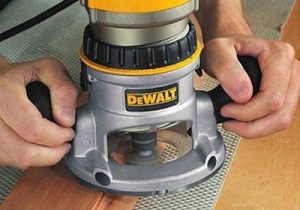
If you’re routing by hand, grasp the handles firmly and maintain a secure grip. Don’t hold them too tightly – you need enough grip to guide the router effectively, but not so much that it becomes tiring. If you’re table routing you should use push tools when working on small items, while larger pieces can usually be fed by hand.
Grip the push tools firmly and try to apply even, constant pressure from behind the workpiece as well as from the side.
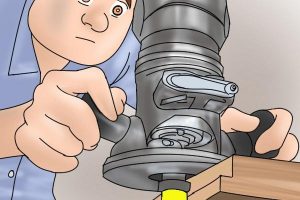
Aim for a consistent feed rate and be alert for problems which may occur at certain places. Corners can be tricky because they are areas where users tend to slow down their feed rate. Mentally prepare yourself before you reach these points, and try maintain a smooth, gliding movement.
Whether you are routing on a table or by hand, the process should always feel relatively effortless. If you ever find yourself forcing the material past the cutter, or vice versa, then your technique needs improvement.

Listen to the sound of the motor while you work. You can usually pick up any early signs of router problems by the sound it’s making, and can also tell whether you are feeding at the right rate.
When approaching the end of a cut, it’s all too easy to unintentionally speed up and rush the cut. This can lead to a rough or uneven edge, so try to keep your movement smooth and consistent right to the end of each pass. Wait until the router bit has completely stopped turning before removing the tool from the workpiece.
Using a DeWalt Router on Different Materials
Routers are mainly a woodworking power tool but you can also use them with certain other materials. As their properties vary, you will need to approach each material in a slightly different way.
You must also choose a cutter suitable for the material and task, and set an appropriate router speed. Bear in mind that different feed rates will be required for different materials. It’s always a good idea to practise with scraps beforehand if you are going to use a new material for the first time.
Wood
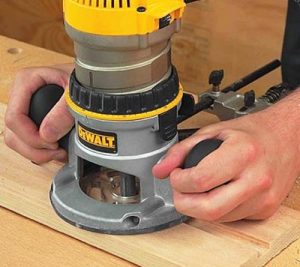
If you’re using hardwood such as oak or beech, try applying a light coat of water to the end grain and leave it for a few minutes before you start cutting. This will soften the wood and make it easier to work on. You should always use a slower speed when routing harder woods.
Check for any knots in the wood before you begin. Small, tight knots will not usually cause problems, but you should still brace yourself and slow down your feed rate when approaching them. Rout along the grain wherever possible for a smoother finish.
Plywood and MDF
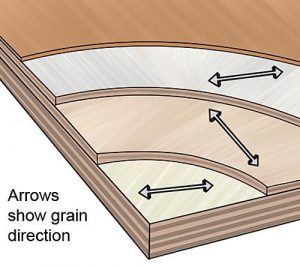
Plywood is a popular material, but it can be difficult to rout successfully because it is made up of multiple layers of wood arranged with their grains running in alternating directions. This makes it particularly prone to tear-out, as you can’t follow the grain.
In comparison, MDF and many other fibre boards are relatively easy to rout, with much less risk of tear-out because there is no grain direction to worry about. However, you should make sure that your work area is well ventilated as these materials throw out a large amount of fine dust when cut.
Laminate
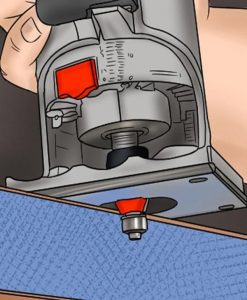
Laminate is produced by coating multiple layers of thin paper with resin and binding them together using a combination of pressure and heat.
The top layer is usually decorative and is often made to imitate the appearance of wood or stone. The laminate is then bonded to a sub layer, usually a material such as fibre board or plywood.
When you rout in laminate, the bit will not only be cutting through the hard layer of laminate but also the composite wood underneath. This makes it a very abrasive material to work with, so you are likely to need trimmers designed specially for laminate – also known as pierce and trim cutters.
To avoid putting additional strain on the cutting edges of the bit, only shave off a couple of millimetres of material at a time. Specialist small, lightweight laminate trimmers are also available.
Plastic

Plastics can be hard or soft. Hard plastics include nylon, acrylic, uPVC, laminate and hard PVC. These materials tend to splinter easily, and the cutter might remove large chips instead of slicing cleanly through.
Some examples of soft plastics include polyethylene, polycarbonate, soft PVC and polypropylene. These plastics are easier to work with and the excess material often comes away in the form of curls rather than chips, resulting in a cleaner cut.
We recommend using a solid tungsten carbide (STC) bit when working with any type of plastic, as a super high-speed steel (HSS) cutter will soon become blunt.
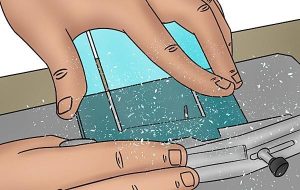
When routing plastic it is particularly important to use some kind of dust collection system to deal with the effects of static electricity.
Once you start cutting, the plastic fragments removed by the bit will become electrically charged and will cling to absolutely everything. The shavings are very difficult to sweep up, so using a suitable dust extractor while you work could save you hours of frustration.
Metal
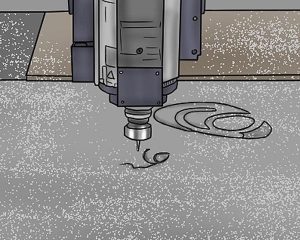
Most routers can be used on aluminium, which is relatively thin and lightweight, but most other metals are best tackled with a heavy-duty CNC router. Only use bits made from HSS steel or solid tungsten carbide.
Feed the aluminium through very slowly, making your passes as shallow as possible to avoid damaging the cutter. You will need to use a wax stick or lubricant to keep both the bit and the workpiece cool. Specialist cutters for routing aluminium and uPVC are widely used in the door and window industry.
How to avoid Tear-Out?
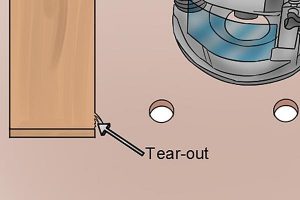
Tear-out can happen when the fibres that are being routed are left unsupported. Although this can occur during any routing task, it is particularly common when making an irregularly shaped or curved item.
Tear-out is most likely to happen when routing along the edge grain or end grain of a workpiece. However, there are a number of steps you can take to reduce or prevent it.
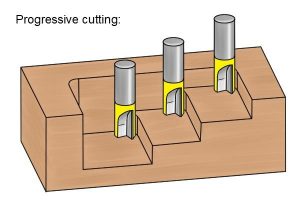
Always use sharp router bits. Blunt bits will grab and pull at the material instead of cutting cleanly through it, leaving a rough finish and increasing the likelihood of tear-out.
You should also cut progressively. Trying to remove too much material in one go is another common cause of tear-out. When making a deep cut, gradually remove small quantities of stock in a series of shallow passes. Aim to remove about 3mm of wood with each pass until you reach the required depth.
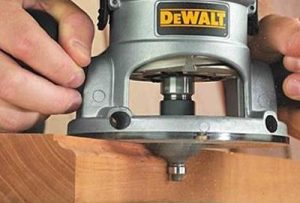
Try to follow the direction of the wood grain wherever possible. This will help you to make a smoother cut. If you rout against the grain, the wood fibres may catch on the bit and break apart to create tear-out.
If you are working on every edge of the workpiece, we recommend you rout the end grain first so that you can then get rid of any tear-out when routing the adjacent edges.
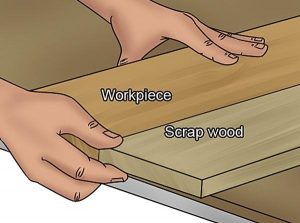
When the router bit reaches a corner of the workpiece it will often snag on the grain of the wood, causing tear-out. Clamping a spare block of wood on to the end of your work will support the edge of the workpiece and help prevent its wood fibres from breaking.
If you’re making a straight cut using a table-mounted router, a zero-clearance fence will give good support to your workpiece and reduce the likelihood of tear-out. As the material moves past the router bit it will be bolstered straight away by the out-feed side of the fence, making tear-out less likely.






